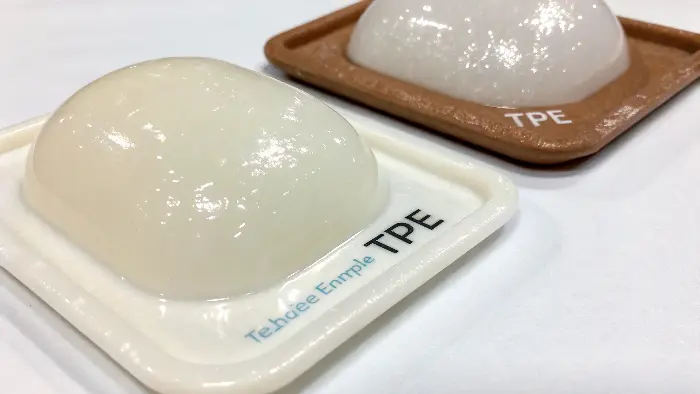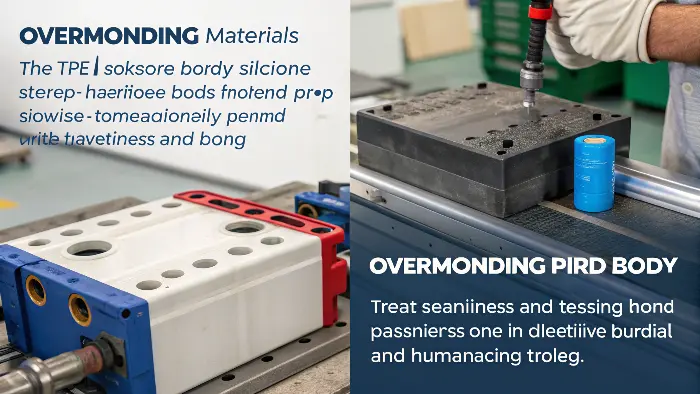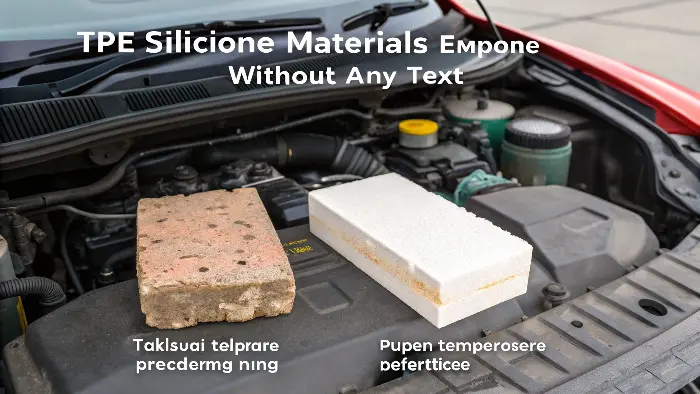Choosing between Thermoplastic Elastomers (TPE) and silicone for your product’s seals, grips, or overmolded features can be a confusing process. Make the wrong choice, and you could be facing delaminated grips, failed seals, or a product that feels cheap, leading to costly redesigns and unhappy customers. Getting this fundamental material decision right from the start is critical for launching a successful and reliable product.
For most consumer products requiring a soft-touch feel, good grip, and easy processing, TPE is the superior choice due to its lower cost and ability to chemically bond in overmolding. However, for applications demanding high-temperature resistance, medical-grade biocompatibility, or long-term seal performance under compression, silicone is the unmatched, high-performance option. The best material is the one that meets your specific performance needs without over-engineering and inflating your budget.
![]()
Throughout my career in mold manufacturing, I’ve seen this exact decision point make or break countless projects. A designer like you, Jacky, knows that the material specified on a CAD drawing has massive real-world consequences for performance, manufacturability, and the final cost of the part. It’s a choice that deserves careful consideration. Let’s break down the key differences so you can select the right elastomer with total confidence.
Is TPE a good substitute for silicone?
You’re designing a product that needs a premium, soft, rubbery feel. Silicone seems like the perfect fit for performance, but then you see the price tag and your budget tightens. You start looking at TPE as a more affordable alternative, but you’re worried. Will it feel as good? Will it last? You’re caught between the desire for high performance and the very real pressure of project costs.
Yes, TPE is an excellent and very common substitute for silicone in a wide range of applications, particularly for consumer goods. It provides a similar soft feel and flexibility at a significantly lower cost. However, it is not a direct replacement in scenarios that demand high-heat resistance (like bakeware), superior compression set for critical seals, or the level of biocompatibility required for medical implants. TPE is the cost-effective choice, while silicone is the high-performance specialist.

I often explain this to clients by comparing a high-end kitchen spatula to the handle of a power drill. The spatula head is almost always silicone. It needs to withstand the heat of a hot pan without melting and be completely food-safe. The soft grip on the power drill handle, however, is a perfect job for TPE. It provides excellent grip and vibration damping, it can be easily molded onto the hard plastic housing, and it keeps the overall cost of the tool competitive. Using expensive silicone for the drill handle would be overkill.
When TPE is the Smart Substitution
TPE truly shines in applications where cost, processing ease, and design flexibility are the primary drivers. It’s the go-to material for millions of everyday items.
- Soft-Touch Grips: This is TPE’s home turf. Think about toothbrush handles, razor grips, power tool overmolding, and soft-touch buttons on electronics. It provides a comfortable, non-slip surface and can be easily molded in a rainbow of colors.
- Consumer-Grade Seals & Gaskets: For things like the seal on a reusable food container or a weather seal on a window, TPE works perfectly. These applications don’t see extreme temperatures or pressures, so the superior compression set of silicone isn’t necessary.
- Recyclability: As a thermoplastic, TPE can be melted and reprocessed. This is a significant advantage for companies focused on sustainability, as factory scrap can be reused, reducing waste and cost.
When Silicone is Non-Negotiable
Despite TPE’s versatility, there are applications where only silicone will do. Its unique chemistry makes it irreplaceable in demanding environments.
- High-Temperature Applications: If your part will be exposed to temperatures above 120°C (250°F), you need silicone. This includes kitchenware like baking molds and spatulas, as well as industrial and automotive seals near engines or exhaust systems.
- Medical and Food-Grade Purity: Silicone is incredibly inert and biocompatible. This makes it the only choice for medical devices that are implanted or have prolonged contact with the body, as well as baby bottle nipples and food-safe tubing.
- Long-Term Sealing Performance: Silicone has a very low "compression set." This means when it’s compressed to form a seal, it pushes back with consistent force for a very long time. TPEs can "take a set" over time, meaning they lose their springiness and the seal can fail. For critical gaskets in engines or aerospace applications, silicone is the only reliable choice.
| Application Example | Best Choice | Key Reason |
|---|---|---|
| Power Drill Handle | TPE | Excellent grip, lower cost, easy to overmold. |
| Oven Mitt | Silicone | Superior high-temperature resistance. |
| Reusable Container Lid Seal | TPE | Good sealing for low pressure, cost-effective. |
| Engine Gasket | Silicone | Low compression set and high-heat/oil resistance. |
| Baby Bottle Nipple | Silicone | Unmatched biocompatibility and purity. |
Which material is better for overmolding, TPE or silicone?
You’re designing a product with a hard, rigid body and a soft, comfortable grip. The success of this design hinges on that soft material staying permanently attached to the hard plastic. You’ve seen products where the grip starts to peel away at the edges, and you know that’s a critical quality failure you have to avoid. Which material will give you that strong, reliable bond you need?
For overmolding onto common rigid plastics, TPE is overwhelmingly the better, easier, and more cost-effective choice. Many grades of TPE are specifically engineered to form a strong, chemical bond with substrates like ABS, PC, and Polypropylene during a standard two-shot injection molding process. Overmolding with silicone is a more complex and expensive process that usually relies on mechanical interlocks or special primers, as it does not naturally bond with thermoplastics.

This is one of the most practical differences I deal with in my factory. When a client brings me a design for a two-material part, my first question is always about the materials. If they’ve designed for a TPE overmold, I know we can use our standard two-shot machines for a fast, efficient, and highly reliable process. If they’ve specified silicone, I know we need to have a much more detailed conversation about mold design, primers, and cycle times, all of which impact the final part cost.
The Power of the TPE Chemical Bond
The magic of TPE overmolding lies in its thermoplastic nature. The process, known as two-shot or multi-shot molding, is beautifully efficient.
- First Shot: The rigid substrate (let’s say an ABS handle) is molded in the first cavity of the mold.
- Mold Rotation: The mold opens, rotates the core holding the ABS handle to a second cavity.
- Second Shot: The mold closes, and molten TPE is injected directly onto the specific areas of the ABS handle.
The key is that the hot, molten TPE slightly melts the surface of the still-warm ABS substrate. As the two materials cool together, they form a permanent, cohesive chemical bond at the interface. It’s not just stuck on; it’s welded together. There are many different grades of TPE, and it’s crucial to select a grade specifically designed to bond with your chosen substrate (e.g., a TPE that bonds to PP won’t bond to PC).
The Complexity of Silicone Overmolding
Silicone, specifically Liquid Silicone Rubber (LSR) used in injection molding, is a thermoset. It cures via a chemical reaction in the mold and does not re-melt. Therefore, it cannot create that simple melt-bond with a thermoplastic substrate. To achieve a bond, you have to get more creative and technical.
- Mechanical Interlocks: This is the most common method. You have to design the rigid substrate with features like undercuts, grooves, or through-holes. The liquid silicone flows into these features and, once cured, is physically locked in place. This requires very careful part design to ensure the lock is robust and the silicone can fill all the features properly.
- Primers and Adhesives: A second option is to mold the plastic part first, then apply a special primer or adhesive in a secondary operation before overmolding it with silicone. This adds a step, labor, and cost to the process.
- Self-Bonding LSR: There are newer, specialized grades of LSR that can achieve a chemical bond with certain plastics, but they are more expensive and can have a very specific and tricky processing window to achieve a good bond.
| Aspect | TPE Overmolding | Silicone (LSR) Overmolding |
|---|---|---|
| Bonding Method | Chemical (melt bond) | Primarily Mechanical; or primers/special grades |
| Process | Simple two-shot injection molding | Complex; may require secondary operations |
| Substrate Design | Simple surface contact is sufficient | Requires undercuts, holes for mechanical lock |
| Cost | Lower (faster cycles, less complexity) | Higher (slower cycles, complex tooling/process) |
| Reliability | Excellent, permanent chemical bond | Good, but dependent on mechanical design |
How do TPE and silicone compare in terms of temperature and chemical resistance?
Your product’s seal will be used in an engine bay, or perhaps the grip you’re designing will be used by mechanics and constantly exposed to oils and grease. You know that heat and chemicals are the enemies of many plastics. Choosing a material that breaks down, swells, or gets brittle in its working environment is a recipe for disaster, leading to leaks, product failure, and serious safety concerns.
Silicone offers vastly superior resistance to both high and low temperatures and has a broader profile of chemical inertness compared to TPE. Silicone can easily handle continuous service temperatures of 200°C (392°F) and above, while most TPEs begin to fail around 120°C (250°F). While TPEs resist many common chemicals, silicone is more resistant to oils, solvents, and UV radiation, making it the clear choice for harsh environments.

I once worked with a client on a handheld diagnostic tool for auto mechanics. They initially chose a stylish gray TPE for the outer protective bumper. It looked great and felt perfect. However, during field testing, we got reports that the bumpers were becoming soft and "gummy." We discovered that prolonged exposure to brake fluid and certain engine oils in the workshop environment was attacking the TPE. We had to re-tool and switch to a more chemically resistant grade, a costly lesson in the importance of matching the material to the true end-use environment.
Temperature Stability: The Silicone Advantage
The core difference comes from their molecular structure. Silicone has a strong, stable backbone made of silicon and oxygen (like glass or sand), which gives it incredible thermal stability.
- High-Heat Performance: This allows silicone to be used for oven seals, automotive gaskets, and medical tools that are sterilized in a high-heat autoclave. A TPE would simply melt or deform in these conditions.
- Low-Temperature Flexibility: Silicone also excels in the cold, remaining flexible and elastic at temperatures down to -50°C (-58°F) or lower. Many TPEs will become stiff and brittle at these temperatures, making them unsuitable for seals in freezing environments.
- UV and Ozone Resistance: That stable backbone also makes silicone naturally resistant to breakdown from sunlight (UV) and ozone, which is why it’s often used for long-term outdoor seals and electrical insulation. Most TPEs require special additive packages to achieve similar outdoor durability.
Chemical Resistance: A Matter of Degree
While silicone is the overall champion, TPEs are not without their merits, and their performance can be quite good depending on the specific chemical and TPE grade.
- TPE’s Strengths: TPEs generally have excellent resistance to water-based solutions, including many acids and bases. This makes them perfectly suitable for applications where they might be exposed to cleaning agents or general moisture.
- TPE’s Weaknesses: The primary weakness for most common TPEs (like SEBS-based types) is their poor resistance to non-polar substances like oils, fuels, and many organic solvents. Exposure can cause the TPE to swell, soften, and lose its physical properties, just like in the diagnostic tool example. There are specialized, more expensive grades of TPE (like TPVs) that offer better oil resistance, but they still typically fall short of silicone’s performance.
- Silicone’s Inertness: Silicone is generally "non-reactive," meaning it doesn’t react with most chemicals. This makes it a reliable choice for seals in chemical processing, medical applications where it might contact various drugs, and in automotive applications where exposure to a wide range of fluids is a certainty.
Conclusion
Ultimately, the choice between TPE and silicone is not about which is "better," but which is right for your job. TPE is the cost-effective, versatile workhorse for countless consumer products, excelling in grips and overmolding. Silicone is the high-performance specialist, the undisputed choice for applications that demand extreme temperature, chemical, or UV resistance and biocompatibility. By clearly defining your product’s needs, you can confidently select the elastomer that delivers the right performance at the right price.
